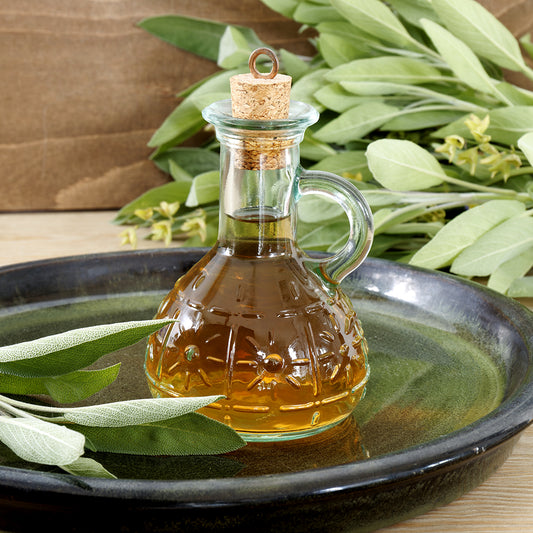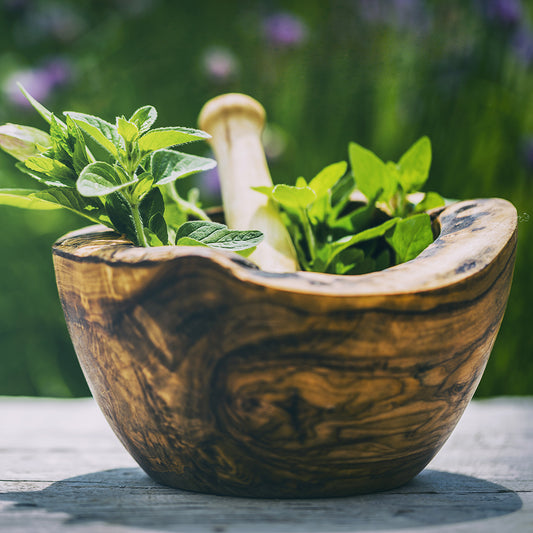Herbal Basics: Fresh vs Dried Herbs
How to Harvest Fresh Herbs
How Preserve Fresh & Dried Herbs
 When using herbs for culinary or therapeutic use, one of the most common questions is ... Which is better, dried or fresh herbs?
When using herbs for culinary or therapeutic use, one of the most common questions is ... Which is better, dried or fresh herbs?
Herbs for Culinary Use
For culinary use, the choice of fresh vs dried herbs really depends on the herb as well as how it will be used.
Dried herbs are best if added during the cooking process so their flavors have time to infuse. Dried herbs are great for stew, soup, or braising.
The bright flavors of fresh herbs are best used to finish a dish such as sprinkling dill over steamed vegetables or adding basil to a fresh pasta dish.
Some dried herbs like rosemary, thyme and oregano have a deeper, spicier flavor than their fresh counterparts. If your recipe calls for fresh herbs you can often substitute dry herbs. However, since you don't want the stronger dried herb flavor to overpower your dish, a good ratio is 1 to 3. For example, if a recipe calls for 3 teaspoons of fresh thyme, use 1 teaspoon of dried.
Other herbs like dill, parsley, and basil can change or loose flavor when dried. For example the flavor of dried basil would not complement a pasta dish very well.
Herbs for Skincare Products
 Herbs used for skin care are usually infused. The choice of fresh vs dried herbs depends on the liquid used for the infusion.
Herbs used for skin care are usually infused. The choice of fresh vs dried herbs depends on the liquid used for the infusion.
“Infusion” is a general term used to describe the method of soaking plant material in a liquid in order to impart its scent, chemical compounds, and nutritional benefits to the medium.
When making water-based infusions like a hair tea or facial mist you can use fresh or dried botanicals.
For infused vinegars or alcohol you can also use fresh or dried herbs.
When infusing botanicals in oil I always recommend dried herbs for the best results and the longest shelf life. The moisture content of fresh herbs may cause mold to form in oil infusions.
Dried herbs have some advantages over fresh herbs when using them to make tinctures or herbal infusions for skin care.
- If properly stored away from heat, light, and moisture, the average shelf life of a dried herb is up to one year
- Drying not only helps preserve the valuable plant elements but also increases their concentration as a percentage of the weight of the herb--so you get more with less
- Fresh herbs can add unwanted moisture, especially to oil infusions, which can lead to bacterial or mold growth
We use dried herbs in our skincare products. Drying concentrates the herbs and then the infusion process actually liberates the nourishing components.
How To Keep Fresh Herbs Fresh—for a little while
As Autumn approaches I will be harvesting my herbs for drying. Even though dried herbs are great to use when roasting, I like to use fresh sage, rosemary, and thyme for many of my Thanksgiving dishes. So this is what I do . . .
- After cutting wet the herbs
- Wrap the wet herbs in a dry paper towel
- Place the wrapped herbs in your vegetable crisper and forget about them until Thanksgiving!
This method works really great for herbs like sage, thyme, and rosemary. When I want to save more delicate herbs like parsley or basil, I use the same process only I place the paper towel in a ziplock bag or plastic container. You want to keep these tender herbs in a moist, but not a wet, environment or they will become moldy.
Drying Your Own Herbs
 Drying herbs is probably the best known method for preserving summer herb surpluses. Properly dried herbs (that are also properly stored) can be safe from bacteria and mold and should remain potent for 6 months to 2 years depending on the herb.
Drying herbs is probably the best known method for preserving summer herb surpluses. Properly dried herbs (that are also properly stored) can be safe from bacteria and mold and should remain potent for 6 months to 2 years depending on the herb.
A "fresh" dried herb should still have some color and the aromatic scent should be there when crushed. Old herbs will be tasteless!
The basic idea when preserving herbs is to remove moisture.
There are so many different ways of drying fresh herbs, but I am going to share the method that I use, which is simply based on air circulation.
This process works best with herbs that have a low moisture content, like Bay Leaves, Oregano, Dill, Rosemary, Tarragon, and Thyme. Although many herbs, especially annuals, have a peak flavor time for harvesting and drying, I tend to wait until autumn to harvest.
- The best time to harvest leafy herbs is a sunny mid-morning after the dew has dried.
- Cut sprigs from your plants and remove old, dead, or wilted leaves.
- It is not necessary to wash herbs if they are grown without pesticides or other chemicals. If you need to wash them rinse with cool water, place them on paper towels, and allow them to dry completely -- wet herbs will mold and rot. Alternatively, if it is a sunny or breezy day you can give your whole herb plant a bath and let it dry before harvesting.
- Remove some of the lower leaves from the sprig so there will be an area to tie.
- Make small bundles of 4 - 6 sprigs, to assure good air circulation and tie them with cotton string.

- Hang them upside down to dry, leaving a few inches between each bundle, in a dust-free place with plenty of ventilation and no direct sunlight.
- If you do not have a dust-free place, you may need to protect your herbs while they dry. Cut a small paper bag so that its length allows a few inches of the herb to peek out. Make a hole in the bottom center and fish the stringed herbs into the bag. Make sure the herbs are not crowded inside the bag. Poke several holes in the paper bag to allow for circulation. Hang the bag upside down.
- Check herbs weekly until they are dry and ready to store.
Learning to tell when your herbs have dried can take a bit of practice. If they are not dry enough, they may still mold. If they are too dry, you will lose the volatile oils that add culinary flavor and therapeutic effectiveness.
When herbs are dried properly, the leaves will crumble easily into little pieces between your fingers. If the leaves turn to powder when crumbled, they are too dry.
If you are not sure that the herbs are completely dry, place a small piece in a tightly sealed glass jar and set the jar in a warm, sunny spot for a few hours. If there is still moisture in the leaves you will see condensation inside the jar.
When I first started drying herbs, I hung them all over my kitchen. It made the kitchen feel so rustic and natural. I soon learned that the kitchen is not a good place for drying herbs. Smoke, scents wafting from food preparation, and all the hubbub in a kitchen, can cause a residue build-up and affect the flavors of delicate herbs.
Storing Dried Herbs
 Whether purchasing or preparing your own dried herbs, it’s important to know that their potency and flavor will degrade over time.
Whether purchasing or preparing your own dried herbs, it’s important to know that their potency and flavor will degrade over time.
The more surface area that is exposed to air, the shorter the shelf life. That means that it may be best to store dried herbs in larger pieces.
- Store your dried herbs in airtight containers in a cool, dry place away from sunlight. I like to use small glass jars with lids. You can also use plastic containers or zip lock bags. It’s a good idea to label and date your herbal containers.
- I store herbs whole and crumble them when I use them. The larger the piece, the smaller the exposed surface area from which flavorful and therapeutic oils can evaporate.
- If you notice the herbs are losing their color and scent, they are also losing their flavor and potency. Dried herbs are best used within a year.
A good rule of thumb for cooking:
Use 1 teaspoon of dried herbs in place of 1 tablespoon of fresh herbs.
Freezing Fresh Herbs
For herbs with a higher moisture content like mint, parsley, basil, or chives, drying can change the flavor dramatically and may not be an effective option for preservation.
For these herb freezing may be the best option. Freezing is fast, easy and retains much of the flavor, smell and nutrients found in fresh herbs. Although the result is not a pretty herb to be use for a salad or garnish, they are great for sauces. There are many different ways to freeze herbs.
To Freeze Bare Herbs
My favorite way to freeze hardy herbs like rosemary, dill, thyme, sage, tarragon or bay leaves or sage is to simply lay them in a single layer on a cookie sheet and place in the freezer. Once frozen, transfer into any airtight container for freezer storage without clumping.
I have also done this method with chives and scallions except I chop them first and then lay them on the cookie sheet.
While basil is a more finicky herb, I often place a bunch on leaves, loosely packed in a freezer bag, leave the bag open, place it in the freezer and then close the bag once frozen. Again I would not use this basil as a garnish or in caprese salad, but it is great for sauces and pizza.

To Freeze in Oil
I love to make lots of basil pesto at the end the season and freeze it to use all year. The same idea works well for other herbs like oregano or thyme to be used in recipes where both oil and herbs are needed.
- Harvest the leaves and combine about a cup of fresh herbs with 1/4 cup of olive oil in a food processor.
- Pulse to blend, then transfer into ice cube trays.
- Once frozen, move cubes into an airtight container for long-term storage.
You can also retain whole leaves, especially for herbs with small leaves like thyme. Simply place the leaves in the ice cube tray, cover with oil and freeze.
To Freeze in Water
Another easy method using ice cube trays for long-term storage of tender herbs like mint, parsley and cilantro is to freeze in water. Remove the leaves. Pack either whole or chopped leaves into ice cube trays, cover with water and pop into the freezer. Once frozen, cubes can be transferred into a storage bag or airtight container. This method is great for herbs used in sauces or soups.
Join us next time when we discuss "How to Choose Good Quality Herbs"



